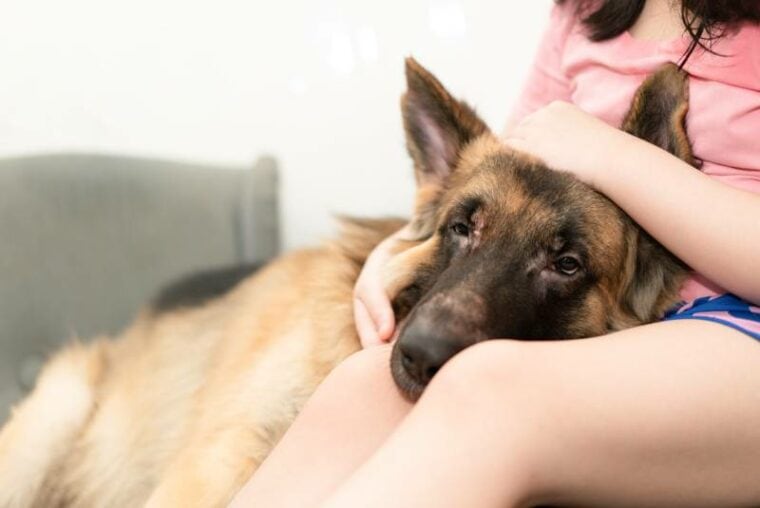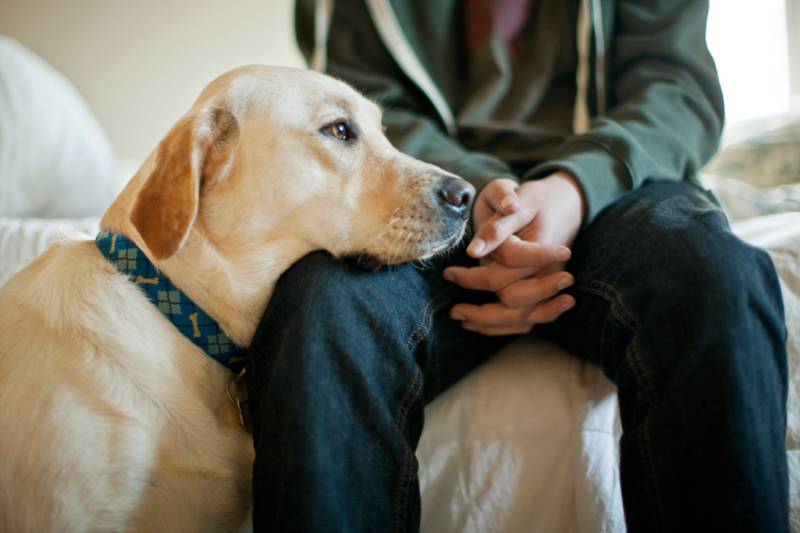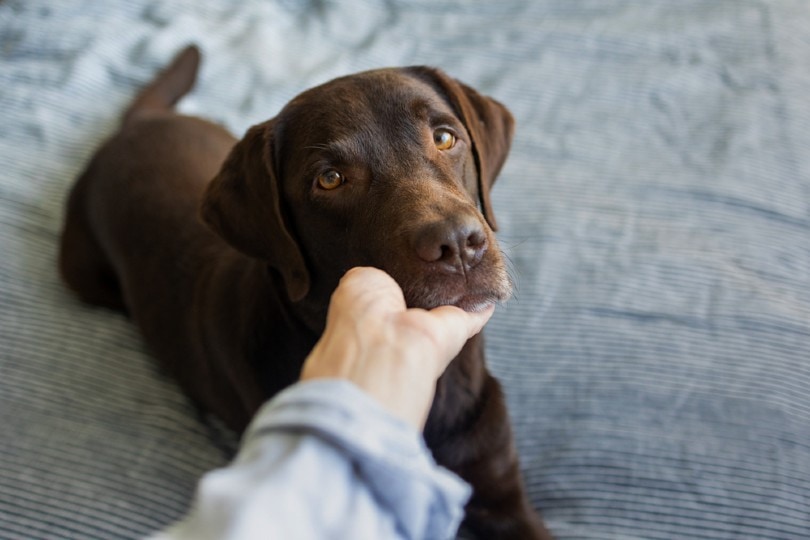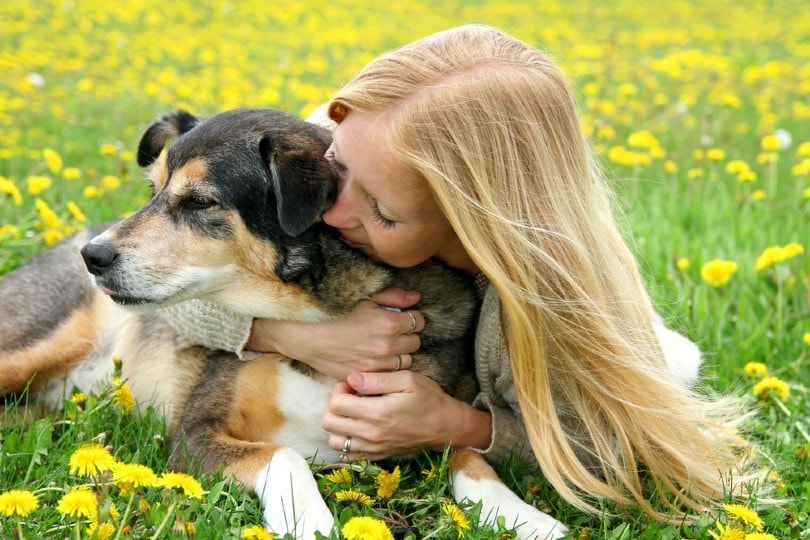
For those of us in veterinary medicine, it seems as if dog anxiety has worsened over the last few years. With adoptions soaring during the pandemic, and owners and dogs alike rarely leaving the house and socializing, the anxious state of ourselves and our pets seems to be at an all-time high. But how can you calm your anxious dog?
Continue reading for my step-by-step guide for how to calm your anxious dog.
The 6 Steps to Calm an Anxious Dog
1. Calm Yourself First
This may sound like common sense, but truly the first best step in calming an anxious dog is for you yourself to first be calm. Oftentimes, anxious owners will feed their own dog’s anxiety and vice versa. If you are pacing, chewing your nails, tapping your feet, and showing anxiety, your dog is going to look at you and wonder if they should be expecting something to happen. If your dog is already prone to anxiety, this will just make them worse.
If you notice that your dog is anxious, take a few minutes to calm your own nerves and anxiety. Project a calm, confident demeanor to your dog so that they aren’t wondering what’s coming next.

2. Create a Safe Place
Every indoor pet, but especially an anxious pet, needs a safe place in the house. This should be an area where your dog can put themselves, or where you put them, that they can both feel and be safe and protected.
For some dogs, this is a kennel with their favorite fluffy bed. Some dogs do even better when you put a blanket or a towel over the crate to block out more environmental triggers. Other dogs will do well inside a closet or a small room, such as the bathroom or laundry room. Place a nice comfortable bed for them in the safe place, maybe some toys and treats. You can even add a sound machine or pheromone dispensers to keep your pet as calm as possible.
This safe place should be used whenever your dog is already acting anxious, or you anticipate they’ll be anxious, such as having guests in the house or leaving for extended periods of time. Safe places help to keep the pet safe from self-harm or even getting off the property and getting hurt.
3. Ignore What is Making Your Dog Anxious
For instance, if your dog becomes anxious and stressed out during fireworks and thunderstorms, one of the best things you can do is act like you can’t hear the loud “booms” outside. Go about your business as if it was any other day or night, as if there aren’t any loud noises outside.
If your dog becomes anxious when you walk it past another dog, a skateboarder, or a loud car, keep walking as if you didn’t even notice their trigger. It’s important to note, however, that if your dog is extremely leash-reactive and difficult to control, proper training and potentially a basket muzzle may be recommended! If your dog is otherwise great on a walk and just gets occasionally startled and anxious, keep yourself calm (see step 1), and keep on with the activity.
Other dogs may get separation anxiety. One of the best things you can do is continue on your schedule and don’t feed into your dog’s anxiety while they watch you getting ready to leave. This doesn’t mean you don’t feed and walk them, give them treats and/or any positive attention. This simply means don’t get anxious while you are getting ready to leave or acknowledge that you notice they’re getting anxious. Treat it like any other time in the house.

4. Distract Your Dog
Some dogs can be distracted out of their anxious state with food and/or toys. If your dog is again anxious with events such as storms, try to offer them their favorite toy to play with or a frozen, food-filled chew toy. Sometimes, these distractions are just enough to completely, or at least temporarily, improve your dog’s anxiety. If their mind has other activities to focus on, all of their attention isn’t on what is making them anxious.
If your dog has separation anxiety, oftentimes, giving them a treat-filled toy (frozen items will last longer) when you leave helps to calm the anxiety of you walking out the door.
Food and toys are also considered “positive reinforcement” for ideal behavior. An anxious dog who is calmly eating their treats and/or chewing on their favorite toy is a much more ideal behavior than ripping up a blanket or chewing a hole in your drywall.
5. Use Physical Touch
This idea goes along with positive reinforcement. Sitting with your dog calmly, ideally while they are in their safe space, and gently massaging or petting them may help to calm some nerves. Many dogs will feel calmer by gentle head and ear massage, or just generalized gentle physical touch. Other dogs may just want you near them to have the assurance you’re close by. Allow your dog to lie next to you and be touching your leg, or even your feet, while you continue to be the picture of serenity.
What you don’t want to do is smother your dog with attention when they are anxious. If that’s not a behavior you would normally do, your already-anxious dog will probably become even more anxious wondering why you are acting so weird. In addition, some people believe too much attention will then reinforce anxious behavior into your dog, making them believe that the anxiety is OK.
While you don’t want to completely ignore your dog if physical touch helps them, you don’t want to force attention onto your dog if they are better off isolated and in their safe space alone.

6. Use Veterinary-Prescribed Medications
Prescription anti-anxiolytics should be considered any time your dog’s behavior is destructive. If your dog gets such bad separation anxiety that they are breaking out of their kennel, chewing through drywall, or breaking out of the house, then doing the above recommendations will likely not be enough. Extremely anxious and/or destructive dogs often benefit from a combination of prescribed medications and a board certified veterinary behaviorist.
If your dog is getting progressively worse with anxiety as they age, or they have just gone through some type of major life change, medications may be beneficial. Do not ever give your own anti-anxiety, anti-depressive medications, or over-the-counter medications to your dog. Some human medications can be severely harmful or even fatal to dogs. Other medications may also have the opposite effect in dogs as it does in humans.
It is also not recommended to try CBD or other herbal calming medications without discussing this first with your veterinarian. Most products that you can purchase online or even at a store are not FDA regulated—there is no way to know if there are harmful ingredients or levels of certain ingredients in the product(s). You may end up doing much more harm than good by giving these products. While some of these products can be helpful, speaking with your veterinarian about what brand, product, and the dose is recommended is always ideal.
Final Thoughts
As a society, the recent years have made a lot of people anxious, or increased anxiety that was already present. We are seeing similar trends in our veterinary patients. Anxiety in dogs is a common complaint, and can range from mild anxiety all the way to severe, destructive, anxious behavior. There are a number of steps you can take to calm your anxious dog. However, if you find your dog is worsening, none of the recommendations work, and/or they are being severely destructive, speaking to a behaviorist and getting prescribed anti-anxiolytics may be beneficial.
- See also: 9 Dogs Prone to Anxiety (With Pictures)
Featured Image Credit: Vach cameraman, Shutterstock







